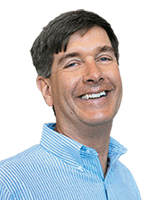What do turfgrass scientists talk about?

Cark Throssell
Imagine what happens when you get 200 or 300 turfgrass scientists together in one location at the same time. It’s non-stop turf discussion on every topic imaginable, and it takes place every year at the Crop Science Society of America (CSSA) annual meeting. My specific interest, and that of about 200 or 300 turf aficionados, is in the C-5 division — or Turfgrass Science division — of the CSSA, where results of the latest turfgrass research are presented.
The primary purpose of attending the meeting is to learn about results of current research projects. In 2016, 185 presentations took place in the C-5 division. Presentations take the form of either a 5-minute or 15-minute oral presentation, or a poster session in which the person conducting the research talks to people one on one or in small groups about results presented on the poster.
Networking also is a big part of the conference. Meetings, meals and hallway conversations all provide opportunities for people to learn about a specific research project, a new product, emerging problems and how to solve an existing problem.
The following three broad topics caught my attention this year.
Brown ring patch management. Frank Wong, Ph.D., Bayer, shared with me that preventive control of brown ring patch is preferable to curative control. Past research shows that several fungicides give good curative control, but recovery is variable and repeat applications may be needed. A potential preventive strategy is to apply early, something that is done for fairy ring management. Make the first fungicide application when soil temperature at a 1- to 2-inch depth reaches 55 degrees F for three or four consecutive days, and use a DMI fungicide such as tebuconazole, triticonazole or metconazole. Make the second fungicide application when the soil temperature at a 1- to 2-inch depth reaches 65 degrees F using the same DMI fungicide, or alternately, azoxystrobin, pyraclostrobin, flutolanil or polyoxin-D if PGR effects are a concern for certain turf types. Lightly watering fungicides into the thatch and mat after application helps with fungicide effectiveness.
Nematode management. The good news is that after many years of limited product choices for controlling nematodes, three new products have reached the market or will reach the market in 2017. The products and their respective manufacturers are Nimitz (Quali-Pro); Indemnify (Bayer CropScience); and Divanem (Syngenta Crop Protection).
Turfgrass undergraduate enrollment. A symposium featuring speakers from six universities with turf programs was held to discuss the decline in undergraduate enrollment in turf programs. The highlights:
- Undergraduate enrollment in turf programs is down across the country.
- The cost of tuition at universities is high and going up. Parents and prospective turf majors question if the investment in a turf management degree is worth the economic return.
- Universities are increasing their entrance requirements. These rigorous requirements are difficult for some potential turf majors to meet.
- Low numbers of turf majors result in low enrollment in turf classes, which causes university administrators to question the need for turf faculty.
- There is strong competition among universities and within a university to recruit students for a specific major.
- Brandon Horvath, Ph.D., University of Tennessee-Knoxville, spoke about their efforts to increase undergraduate enrollment. The turf program hired a professional marketing firm to develop a campaign to recruit undergraduate turf students. The program also is making a sustained effort to ensure that turfgrass faculty and the turf program is visible at events on and off campus. The result of these efforts is a current enrollment of 55 turfgrass undergraduate majors and an upward trend.
It’s nice to know there are a few bright spots in undergraduate turf enrollment numbers, but the national picture is alarming when we think about where the next generation of superintendents is coming from.








